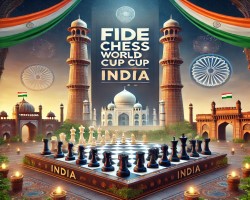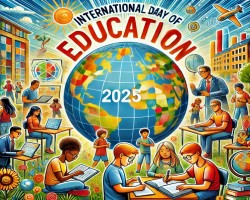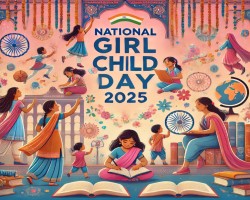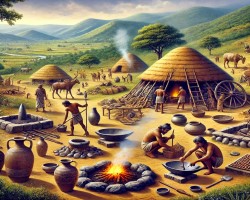UPSC Current Affairs
TABLE OF CONTENTS |
| International Relations |
|---|
|
|
|
Why in the News?
The short film Anuja, set in New Delhi, has received a nomination for the Live Action Short Film category at the 97th Academy Awards. The film highlights child labor issues, following the story of a nine-year-old girl caught between her dreams of education and the harsh realities of factory work. Key Takeaways: About the Film Directed by Adam J. Graves and Suchitra Mattai. Produced by Guneet Monga and Mindy Kaling in collaboration with the Salaam Baalak Trust. Storyline: A nine-year-old girl, Anuja, must choose between pursuing education or working in a factory alongside her sister. Competing Films Other nominees in the Live Action Short Film category include: A Lien The Last Ranger Production and Social Message Collaborates with the Salaam Baalak Trust to address child labor issues. Highlights the difficult choices faced by children in poverty, raising awareness about their challenges. Significance of the Oscars Oscar nominations for 2025 were announced by Bowen Yang and Rachel Sennott, following delays caused by wildfires in Los Angeles. The Academy Awards will be held on March 2, 2025, at the Dolby Theatre, Los Angeles. Related Nominations I Am Ready, Warden, directed by Smriti Mundhra, is nominated in the Documentary Short Film category. Smriti Mundhra was previously nominated for her 2019 film St. Louis Superman. All We Imagine As Light is nominated for the Best Film Not in English Language at the 2025 BAFTA Film Awards. |
| Sports |
|
|
|
Why in the News?
India is set to host the FIDE Chess World Cup 2025, a prestigious global event, marking the country's first major international chess tournament since the 2022 Chennai Chess Olympiad. Key Takeaways Details of the Tournament: Scheduled from October 31 to November 27, 2025. Features a knockout format with over 200 players worldwide. Provides three qualification spots for the Candidates Tournament, which determines the challenger for the reigning World Chess Champion. Historical Context of India’s Chess Achievements: R. Praggnanandhaa: Secured the silver medal at the 2023 FIDE Chess World Cup, losing narrowly to Magnus Carlsen in the final. Viswanathan Anand: The only Indian to win the FIDE World Cup (2000, 2002). Gukesh Dommaraju: At the World Chess Championship 2024, he won the title by defeating Ding, becoming the 18th and youngest undisputed world champion, at the age of 18 years and 195 days. India’s rising prominence in global chess with young talents gaining international recognition. Arjun Erigaisi and the Candidates 2026: Came close to qualifying for the Candidates 2026 via the FIDE Circuit in 2024. Finished just behind Fabiano Caruana, showcasing his skill and potential as a future world chess contender. Significance of India Hosting the FIDE Chess World Cup 2025: Highlights India’s rich chess heritage and strengthens its position in the global chess community. Promotes grassroots chess development and inspires young players in India. Offers Indian prodigies like Praggnanandhaa and Erigaisi a platform to showcase their skills on home soil. |
|
|
|
Why in the News?
The 5th edition of the Khelo India Winter Games (KIWG) 2025 has been inaugurated at the iconic NDS Stadium in Leh, Ladakh. This event marks a significant step in promoting winter sports and culture in India, with the first phase being hosted in Ladakh and the second in Jammu and Kashmir. Key Takeaways Details of the Event Inauguration: KIWG 2025 was inaugurated at NDS Stadium, Leh, despite adverse weather conditions. Phases: Phase 1: Ice sports in Ladakh (January 23–27, 2025). Phase 2: Snow sports in Jammu & Kashmir (February 22–25, 2025). Participation: 19 teams representing States, UTs, and institutional outfits like the Army and ITBP. 594 participants, including 428 athletes. Grand Opening Highlights Ceremony: March Past: Teams displayed enthusiasm by skating past the VIP podium. Cultural Performances: Showcased Ladakh’s art, culture, and heritage. Exhibition Ice Hockey Match: Set the tone for the Games. Dignitaries: Lt. Governor of Ladakh, Brigadier Dr. BD Mishra. PM Narendra Modi extended virtual congratulations. Sports Disciplines Competitions span two ice disciplines and four snow disciplines. Aims to provide a platform for athletes to display their talent at a national level. Vision and Mission Objectives: Nurture talent in winter sports. Promote sports tourism in Ladakh and J&K. Position India as a global competitor in winter sports. Dr. Mansukh Mandaviya's Vision: Dream to hear India’s National Anthem at the Winter Olympics podium. History of Khelo India Winter Games Launch Year: 2020, under the Khelo India Scheme by the Ministry of Youth Affairs and Sports (MYAS). Previous Editions: Participation by 36 States and Union Territories. Ladakh hosting for the second time. Significance: Provides a platform for athletes while showcasing the art, culture, and tourism of the host regions. Role in Sports Development Khelo India Initiatives: Youth Games. University Games. Para Games. Winter Games. Objectives: Identify and nurture talent. Promote fitness and national athletic excellence. Ladakh & J&K: Winter Sports Hotspots Natural terrain and climatic conditions make Ladakh and J&K ideal for winter sports. Hosting KIWG 2025 strengthens their reputation as premier winter sports destinations, attracting both athletes and tourists. Future Prospects Dr. Mandaviya’s Declaration: India as a 4D sports destination (Diverse, Dynamic, Dedicated, and Distinguished). Vision: Achieve global recognition in winter sports. Foster national pride and inspire the next generation of athletes. |
| Important Days |
|
|
|
Every year, the world celebrates International Education Day to mark the importance of education in ensuring peace and development. It was the United Nations General Assembly (UNGA) that “decided to mark the day to demonstrate the unwavering political will to support transformative actions for inclusive, equitable and quality education for all.”
The International Day of Education is celebrated on January 24 annually. This year marks the seventh year of the celebration with the theme ‘AI and education: Preserving human agency in a world of automation.’ International Day of Education History: Since 2018, the day has been authored by 59 member states. The resolution for the same was passed in the UN General Assembly on December 3, 2018. Following the resolution, the first International Day of Education was observed on January 24, 2019. AI & Education: Understanding the theme The theme was chosen to highlight the growing impact of artificial intelligence (AI) and automation on education and the future workforce. As technology rapidly evolves, AI and automation are transforming industries, economies, and how people live and work. The integration of AI and automation technologies into education offers significant opportunities to enhance learning experiences, improve teaching methods, and provide personalized educational pathways. AI-powered tools can address the unique needs of students, making learning more engaging and effective. Additionally, automation streamlines administrative tasks, allowing educators to devote more time to interactive and meaningful student engagement. Note: India celebrates its National Education Day celebrated on November 11 to mark the birth anniversary of India’s first Education Minister Maulana Abul Kalam Azad. He strongly advocated for the education of women. |
|
|
|
National Girl Child Day is an annual observance in India that serves as a crucial platform to promote the importance of girls’ rights and their access to education, health care, and safety within society.
This day highlights the need for collective action to ensure that every girl is afforded the fundamental rights she deserves, fostering a more equitable future for all. The celebrations will take place from January 22 to March 8, 2025, featuring rallies, cultural events, felicitation ceremonies, and campaigns. National Girl Child Day 2025 date and history: National Girl Child Day is celebrated every year on January 24. This year, it falls on a Friday. The day also marks the anniversary of Prime Minister Narendra Modi's Beti Bachao, Beti Padhao (Save the Girl Child, Educate the Girl Child) scheme, launched on January 22, 2015. Established in 2008 by the Ministry of Women and Child Development, this day highlights the importance of empowering and protecting girl children. Significance of National Girl Child Day: In a nation where gender inequality, limited access to education, high dropout rates, child marriage, and gender-based violence persist, this initiative holds great significance. National Girl Child Day seeks to highlight the unique challenges faced by girls while raising awareness about the need to combat discrimination. The day advocates for their rights to health, education, and overall well-being, striving to foster a more inclusive and equitable society that nurtures and supports every girl child. This year, in 2025, the Ministry of Women and Child Development is commemorating the 10th anniversary of the Beti Bachao Beti Padhao Scheme, which started on January 22, 2025, and will conclude on March 8, 2025, culminating on International Women’s Day. Conclusion: National Girl Child Day serves as a vital reminder of the importance of empowering girls and fostering an environment of equality and opportunity. Through various initiatives, policies, and awareness campaigns, the government is actively working to eliminate gender disparities, promote education, and ensure the health and well-being of girls across the nation. These efforts not only uplift individual lives but also contribute to building a more inclusive and progressive society. Recognizing the potential of every girl child is a step toward shaping a brighter and more equitable future for all. |
| Other States |
|
|
|
Why in the News?
In a groundbreaking discovery, Tamil Nadu Chief Minister M.K. Stalin released a report stating that the Iron Age in Tamil Nadu began as early as the 4th millennium BCE, making it one of the earliest regions in the world to use iron. The findings were based on samples excavated from the Sivagalai site in Thoothukudi district. Key Takeaways: Significance of Findings Carbon dating results reveal that iron was used in Tamil Nadu as early as 3345 BCE, over 5,300 years ago. The usage of smelted iron could date back to the middle of the 3rd millennium BCE, marking a significant milestone in global archaeology. Research Validation Samples underwent rigorous testing through Accelerator Mass Spectrometry (AMS) and Optically Stimulated Luminescence (OSL). Labs involved include Beta Analytic Testing Laboratory (USA), Birbal Sahni Institute of Palaeosciences (Lucknow), and Physical Research Laboratory (Ahmedabad). Archaeological Significance The findings suggest that Tamil land had advanced iron-smelting technology over 5,300 years ago. Compared to other metals, iron-smelting requires a high temperature (1,200-1,400°C), showcasing the technological expertise of the region. Global Impact Experts like Dilip Kumar Chakrabarti (Cambridge University) highlighted the global importance of the discovery, marking Tamil Nadu as a pioneer in early iron usage. nRole of Iron in Civilizatio Iron tools revolutionized agriculture, enabling trade and the formation of early states. Unlike northern regions that experienced the Copper Age, the limited availability of copper ore south of the Vindhyas led Tamil Nadu to transition directly into the Iron Age. Related Excavations Excavations at Adichanallur, Mayiladumparai, Kilnamandi, and Mangadu suggest iron usage in Tamil Nadu dates back to 2500-3000 BCE. Technological Mastery: The findings indicate that people in Tamil Nadu had mastered iron smelting technology around 5300 years ago, requiring temperatures of 1,200 to 1,400 degrees Celsius. |
|
<< 23-Jan-25
|
|
|





